|
 Nederlands /
Dutch Nederlands /
Dutch
Wasps, bees, bumblebees
Hymenoptera. The bees, bumblebees, ants, wasps and saw flies belong to that
order.
Hymenoptera is divided into different subordes. Namely suborder Symphyta
(This group has no waist, sawflies) and
suborder Apocrita. Apocrita is also divided into two groups. Namely: Parasitica and
Aculeta.
Parasitica: wasps or parasitic hymenoptera. The females have an ovipositor, with
the ovipositor they lay eggs into or near larvae. These larvae are eaten by the wasp larvae. There are several families.
The largest group are the ichneumon wasp (Ichmonidae). Other groups are:
Braconidae,
chalcid wasps (Chalcidoidea), Gasteruptiidae, gall wasps (Cynipoidea). The plant
galls of gall wasps develop, when the eggs are laid.
Aculeata: In this group the ovipositor is is modified into an
stinger. With this stinger they can defend themselves (bees) or they can
stun a prey. In this group are also wasps with parasitic larvae. Spider
wasps look like ichneumon wasps, but have a sting to stun their hosts.
Jewel wasps (Chrysididae) have a sting too.
|
I have made subpages of some families. On this page I have placed a photo of
one species of the family and a link.
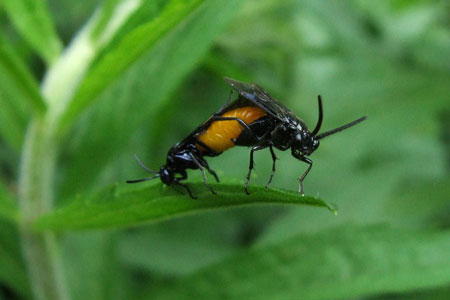
Large Rose Sawfly (Arge pagana) Family Argidae, Saw Flies
(Symphyta)
Saw Flies
(Symphyta). Sawflies are closely related to wasps. But they don't have
the 'waist' of wasps. They
make no nest and have no social organization. Sawfly larvae feed on
leaves. The larvae look similar to the caterpillars, but they have six or
more pair of prolegs. Some larvae look like little slugs.
|
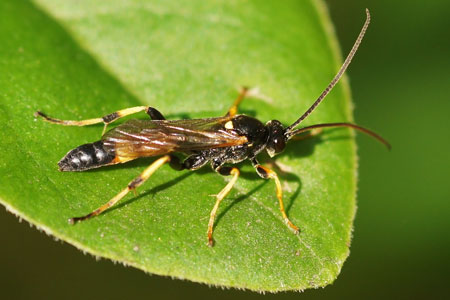
Ichneumon bucculentus Ichneumon wasps
(Ichneumonidae)
Ichneumonidae belongs to the group Parasitica. The females have an
ovipositor. Larvae are parasitic.
|
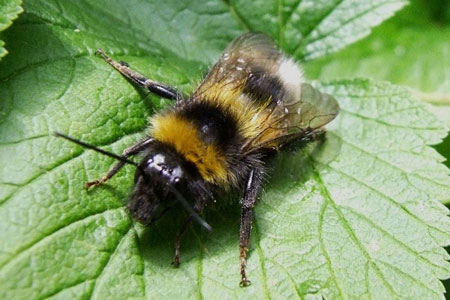
Large Earth Bumblebee, Buff-tailed Bumblebee
(Bombus terrestris) Bumblebees
Bumblebees (Bombus): Big hairy bees of the genus Bombus. They live in colonies. Only the queen
hibernates and starts a new colony next year. The nest is sometimes underground, but can also be built between
clumps of grass. |
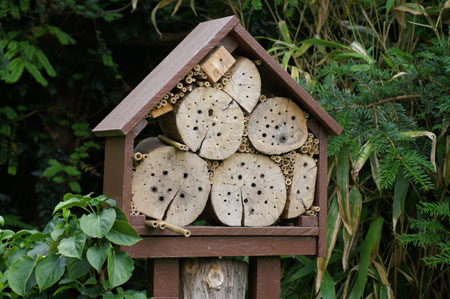
Bee hotel.
|
Social Wasps (Vespidae) Subfamily Paper Wasps, True Wasps
(Vespinae) The other subfamily: the Potter Wasps
The colonies exist one year. Each year the queen starts building a small nest. The nests are
constructed of paper. The paper is made of wood. The wasps have made the paper
by chewing on wood. The first wasps are the workers. In one year there can be
thousands in a colony. At the end of the summer the males and new queens appear. Only the fertilized queens
hibernate.
True wasps have their wings folded longitudinally when at rest. The eyes are kidney shaped.
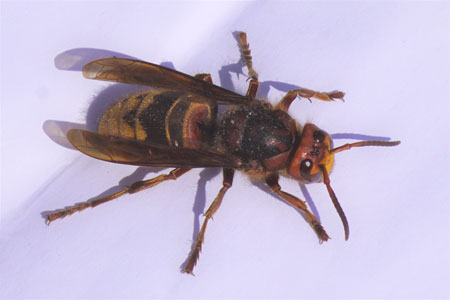 European hornet(Vespa
crabro).
Family Social Wasps (Vespidae). European hornet(Vespa
crabro).
Family Social Wasps (Vespidae).
A queen. A very large wasp. Reddish brown on head and thorax. Resembles the Dolichovespula media, but Vespa crabro has completely reddish brown antennae.
Queen length: 25-35 mm, workers 18-24 mm and males 21-28 mm.
Nests in hollows, especially tree hollows.
Central Europe, parts of Asia. Photo queen: 4-7-2021. The first time in our garden.
 10-8-2022 This time not a queen. German:
Hornisse. French: Frelon européen, frelon
10-8-2022 This time not a queen. German:
Hornisse. French: Frelon européen, frelon |
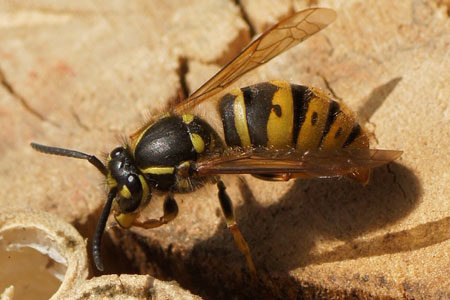 .. ..
 . .
 . .
 Common wasp
(Vespula vulgaris).
Family Social Wasps (Vespidae). Common wasp
(Vespula vulgaris).
Family Social Wasps (Vespidae).
Thie first photos are from a queen. As you can see the queen more robust. The antennae of the males have 13 segments. The scapus (shaft) is the first segment. The workers have 12.
In Holland they are also called lemonade wasps, because they can be annoying in late summer and autumn.
Especially if you drink lemonade.
Queen Length: 16-19 mm, length workers 11-14 mm, length males 13-17
mm.
They look very much like the slightly larger German wasp (Vespula germanica).
The nest will be built underground in old nests of animals, but also in hollow trees and wall cavities.
In 2008 we had a nest between the roof and ceiling of the pantry. Until autumn we had no problem. Only when it was cold, you did see them in the pantry.
There they were walking around very slow. The year after they had disappeared.
Native to Europe, Asia, Japan en Northern America. Introduced
in New Zealand and Australia.
Photos queen: 26-3-2012. Photos worker of the
common wasp: 30-10-2010.
German: Gemeine Wespe French: La guêpe commune. |
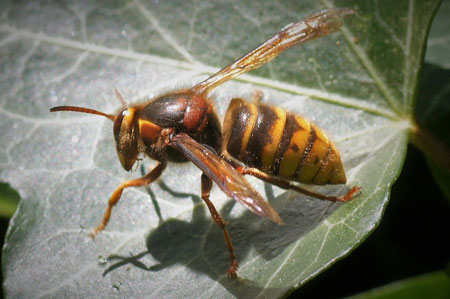 .. ..  . .
 Median wasp(Dolichovespula media).
Family Social Wasps (Vespidae). Median wasp(Dolichovespula media).
Family Social Wasps (Vespidae).
This is also a queen.
They don't bother people unless they come too close to the nest. The queen has a red drawing on the
thorax. The median wasp is variable in colour. Workers and males are often black with narrow yellow bands.
Length of queen: 18-22 mm, length of worker and male 15-19 mm.
Nests are hanging in trees, bushes under the eaves of buildings.
Native in Central Europe, parts of Asia.
Photos queen: 11-5-2017, 13-5-2017. The first time in our garden.
 8-7-2022 This time not a queen. German: Mittlere Wespe, Kleine Hornisse. French: Guêpe des buissons, Petit
frelon.
8-7-2022 This time not a queen. German: Mittlere Wespe, Kleine Hornisse. French: Guêpe des buissons, Petit
frelon. |
 Saxon wasp (Dolichovespula
saxonica).
Family Social Wasps (Vespidae).
Saxon wasp (Dolichovespula
saxonica).
Family Social Wasps (Vespidae).
Looks a lot like Vespula vulgaris. A clear distance between the bottom of the eye and the base of the jaws.
Above-ground nests both in cavities and on the outside. Elongated in shape with the exit at the bottom. They don't bother people
Queen length: 15-18 mm, workers 11-13 mm and males 13-15 mm.
Europe, North and Central Asia. Photo 26-4-2021 German:
Sächsische Wespe. French: Guêpe saxonne. |
Subfamily Polistinae. Family Social Wasps (Vespidae)
Social wasps. Thinner than Vespinae. Smaller nests. In the Netherlands the species Polistes biglumis, Polistes dominula, Polistes gallicus, Polistes nimpha. Only Polistes dominula is not rare.
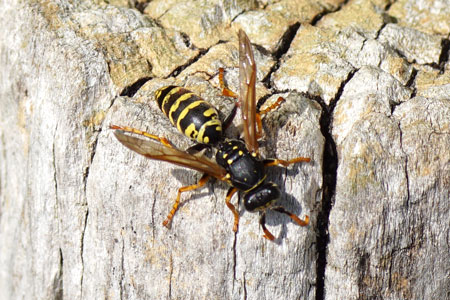 .. ..
 European paper wasp
(Polistes dominula). Subfamily Polistinae).
Family Social Wasps (Vespidae). Not
in the garden, but about 2 km from my home.
European paper wasp
(Polistes dominula). Subfamily Polistinae).
Family Social Wasps (Vespidae). Not
in the garden, but about 2 km from my home.
Oranje antennae, legs en wings. Photos 8-9-2023. |
Potter wasps, mason wasps (Eumeninae). Family Social Wasps (Vespidae)
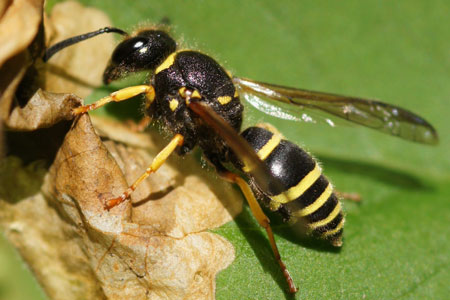 .. ..
 Ancistrocerus
spec. Subfamily Potter wasps, mason wasps
(Eumeninae).
Family Social Wasps (Vespidae). Ancistrocerus
spec. Subfamily Potter wasps, mason wasps
(Eumeninae).
Family Social Wasps (Vespidae).
Characteristic: Black with yellow stripes. A narrow tip.
Most males of the potter wasps have back-curved last segments of the
antennae.
There are many similar species. Ancistrocerus parietum, Ancistrocerus
gazella, Ancistrocerus quadratus, Ancistrocerus nigricornis, Ancistrocerus
oviventris...
The nests can be found in holes in the wood. Like beetle galleries, boreholes. In the cells of the nest
are caterpillars as food for larvae. As with masonry bees, they close the cell. Photos 2-6-2011, 12-4-2012. |
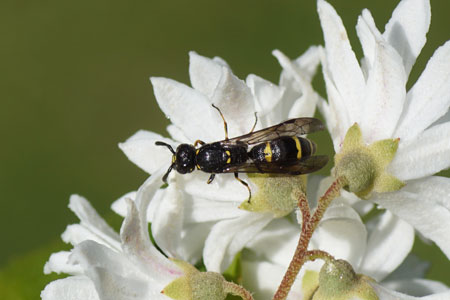 Symmorphus spec. Subfamily Potter wasps, mason wasps
(Eumeninae).
Family Social Wasps (Vespidae).
Symmorphus spec. Subfamily Potter wasps, mason wasps
(Eumeninae).
Family Social Wasps (Vespidae).
Features Black with yellow stripes. They are recognizable by a longitudinal, shallow groove on the first abdomen segment.
The similar species in the Netherlands are: Symmorphus angustatus, S. bifasciatus, S. connexus, Symmorphus crassicornis, S. debilitatus, S. fuscipes, S. gracilis, S. murarius
They nest in holes like in twigs, stems, galls, wood. Separations between cells are made of mud. Adult females prey on
caterpillars and beetle larvae to lay eggs in them. Photo 3-6-2022. |
Solitary wasps
Superfamilie Chrysidoidea.
This superfamily consists of the Bethylidae, the Chrysididae, the Dryinidae and several smaller families.
Bethylidae.
The Bethylidae belong to the superfamily Chrysidoidea and have a sting. They are dark, small to medium sized wasps with a flattened body and short stout legs. The Bethylidae are parasites of larvae of butterflies and beetles. They paralyze their victims by stabbing them (difference Chrysididae). Then they hide it and lay their eggs. The larvae live as external parasites on their 'host'. There are five subfamilies: Bethylinae, Epyrinae, Pristocerinae, Galodoxinae and Mesitiinae (not the Netherlands).
 .. ..
 Bethylus. Subfamily Bethylinae. Family
Bethylidae. Bethylus. Subfamily Bethylinae. Family
Bethylidae.
The four species in the Netherlands are Bethylus boops
(female 2,0-3,0 mm), Bethylus cephalotes (male 2,5-4,5 mm, female 2,5-5,5 mm), Bethylus dendrophilus
(male 2,0-2,5 mm, female2,5-3,5
mm), Bethylus fuscicornis (male 2,0-4,0 mm, female 2,5-4,5 mm). Differences there are among others in
the hairs. Not visible in these pictures.
According to Jeroen de Rond its probably a Bethylus dendrophilus
or a Bethylus boops. Both species have a a sharp triangular snout. B. dendrophilus
has bald eyes, B. boops has hairs on the eyes (not visible in these
pictures). They are both arboreal species.
Photos 29-10-2016. |
Dryinidae.
The Dryinidae belong to the superfamily Chrysidoidea and have a sting. Behoren tot de superfamilie Chrysidoidea.
The larvae of dryinidwasps are ectoparasite on cicadas.
Adult female dryinidwasps usually have a chelate foretarsus for grasping the
cicada during oviposition. The cicada stays alive at that moment. The larva of the wasp
only has the head through the skin of the cicada and is feeding internally on the host.
When it grows it develops a hardened sac-like "case" to protect its vulnerable body.
The host is eventually killed. Pupation occurs on a plant or in the soil. It
overwinters as pupa. They look like an ant and they live often near ant nests.
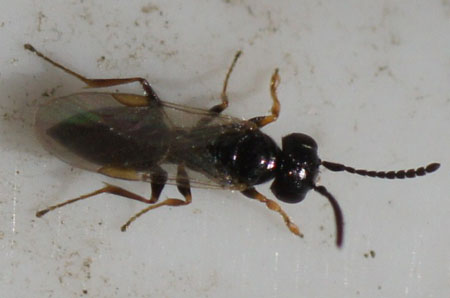 Anteon brachycerum. Family
Dryinidae. Female. Anteon brachycerum. Family
Dryinidae. Female.
The larvae of Anteon brachycerum are ectoparasite on cicadas.
Determined by Jeroen de Rond. Information Jeroen (translated): This miniature wasps are almost impossible to determine from pictures, but this is an exception. The big yellow wing stigma and the thick, beads-like antennae are typical. The species lives as larvae parasitic on birch cicadas. The cicadas have a kind of brown pouch on their backs. From the Netherlands are only about 20 known discoveries since 1980.
Photo 07-04-2012. About the size of an ant. |
Ruby-tailed wasps, jewel wasps, cuckoo wasps
Chrysididae.
Ruby-tailed wasps have a beautiful bright metallic colour. In the Netherlands and Belgium are about 60 species. Identification
of many species is not easy.
They do possess a stinging organ although there is no venom. (most species).
They have a hard
exoskeleton. They need it to protect
themselves, when they meet the host. For Ruby-tailed wasps lay their eggs in
the nests of other wasps, bees. (cuckoo wasps) The larvae of the ruby-tailed
wasps eat the bee or wasp larvae of their host. They are variable in size.
An
illustrated key to the cuckoo wasps
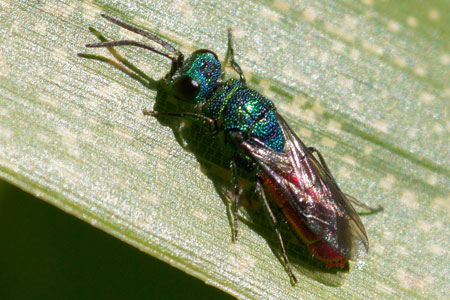 Ruby-tailed wasp, jewel wasp, cuckoo wasp.
Family Chrysididae. Maybe Chrysis ignita. Ruby-tailed wasp, jewel wasp, cuckoo wasp.
Family Chrysididae. Maybe Chrysis ignita.
Of Chrysis ignita a distinction is made between some subspecies. Depending on size and host. But there are more bicolor types as below.
Foto 1-6-2011.
German: Goldwaspe - Gemeine Goldwespe, Feuer-Goldwespe (Chrysis ignita). |
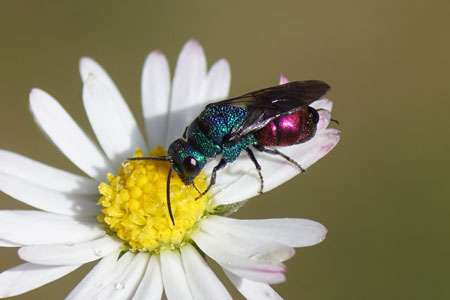 Holopyga generosa
Family Chrysididae.
Holopyga generosa
Family Chrysididae.
Both sexes are bicolored. Length 7-9 mm. Europe, Asia Minor, North Africa, China Photo 6/17/2022. Determined by Milo van Loon |
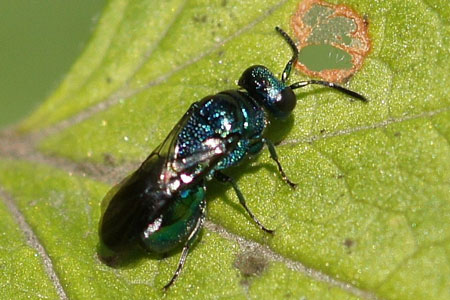 .. ..
 Omalus aeneus
Family Chrysididae. I am not quite sure!
Omalus aeneus
Family Chrysididae. I am not quite sure!
Very similar to Pseudomalus violaceus. Difference: Tergite 3 = short> Omalus
aeneus. Tergite 3 = long> Pseudo Malus violaceus.
This
jewel wasp was about 5 mm. Photos 12-6-2011. Thanks for helping me: Pietsje and Horst
Jux. |
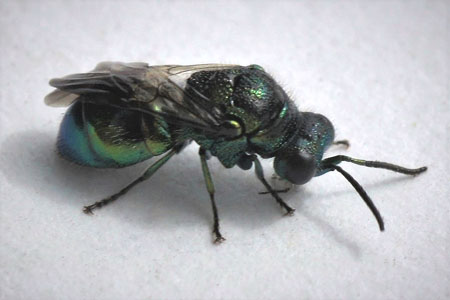 .. ..
 . .
 Pseudomalus violaceus.
Family Chrysididae.
Pseudomalus violaceus.
Family Chrysididae.
Purple green. Length male and female 5-8 mm. Determined by Milo van Loon.
Photos 16-5-2017 |
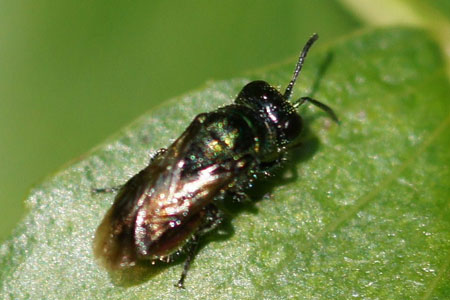 .. ..
 . .
 Pseudomalus auratus.
Family Chrysididae.
Pseudomalus auratus.
Family Chrysididae.
Small, about 3 or 4 mm and again... it was was constantly moving.
Thanks for helping me: Paolo Rosa. Photos 10-7-2011. |
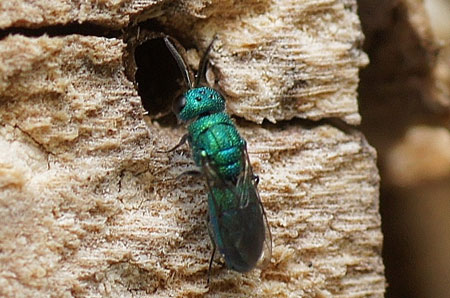 .. ..
 Trichrysis cyanea.
Family Chrysididae. Blue green. About 6 mm. Photos 3-7-2012. Trichrysis cyanea.
Family Chrysididae. Blue green. About 6 mm. Photos 3-7-2012. |
Spider wasps, Pompilidae.
Spider wasps are slender with long legs. Usually they are black with a red or white markings on the front part of the abdomen. Unlike other wasps the first segment of the thorax
(pronotum) of spider wasps extends back to the tegulae (attachment scales of the wings).
They are solitary and hunt spiders. The spider is paralyzed with a poisonous sting
and then dragged into a nest. Or to a place where a nest is made. In the abdomen an egg is laid.
In Belgium and the Netherlands are approximately 70 species. There are four subfamilies.
Ceropalinae, Pepsinae, Ctenocerinae, Pompilinae
They can also stabbing people.
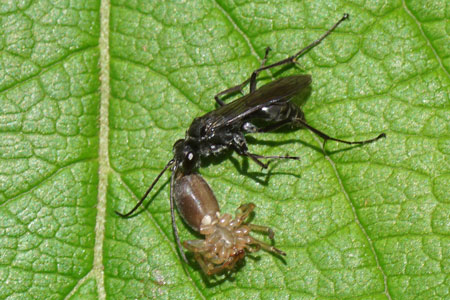 .. ..
 Agenioideus apicalis. Family spider wasps
(Pompilidae).
Agenioideus apicalis. Family spider wasps
(Pompilidae).
An all black spider wasp. The prey consists of spiders of the family Salticidae and spiders of the genus Segestria (Segestriidae). Often on walls. Nests in cavities in walls and wooden posts. One generation per year. 7-13 mm. Photos 12-8-2023. Determined by Jaap Bouwman. |
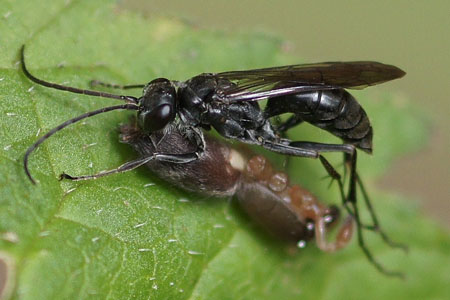 .. ..
 . .
 . .
 Auplopus carbonarius. Family spider wasps
(Pompilidae). Auplopus carbonarius. Family spider wasps
(Pompilidae).
This spider wasp is completely black. The male has white spots on the face. The front of the abdomen is narrowed.
This is a common spider wasp in the Netherlands. The female in this photo drag the spider with it. It has amputated the legs of the spider. This often happens with these spider wasps.
The nests are unexcavated. Usually you can find them in crevices in walls or trees.
Length 7-10 mm. May-August. Photo 13-9-2010.
 Photo 28-5-2013. Auplopus carbonarius male.
Photo 28-5-2013. Auplopus carbonarius male. |
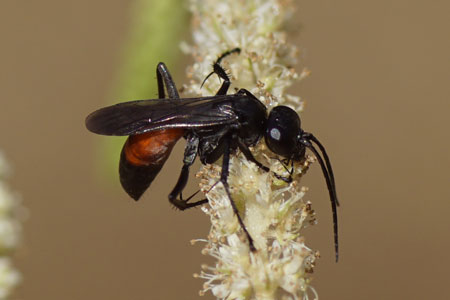 .. ..
 Anoplius infuscatus. Family spider wasps (Pompilidae).
Not quite sure as it has not been checked by an expert!
Anoplius infuscatus. Family spider wasps (Pompilidae).
Not quite sure as it has not been checked by an expert!
Black with orange-red. It resembles spider wasps from the genus Arachnospila. But the veins in the wings are different.
Photos 25-6-2023. |
Digger wasps.
The digger wasps are divided into 2 different families, the Sphecidae and
Crabronidae. Digger wasps are solitary wasps. They dig nests (tunnels) in sandy soil. They stock their nests with different
kind of prey. The prey depends on the wasp species. Mostly insects, but
sometimes spiders.
Crabronidae.
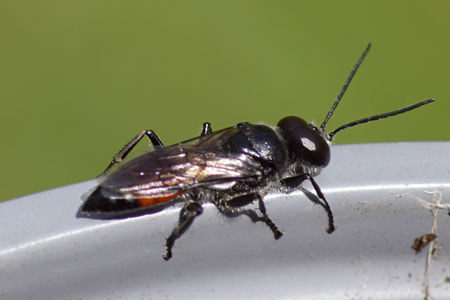 Astata boops. Subfamily
Astatidae.
Family Crabronidae or
family Astatidae. Astata is considered to belong to the subfamily Astatidae of the family Crabronidae. But also often to a separate family
Astatidae.
Astata boops. Subfamily
Astatidae.
Family Crabronidae or
family Astatidae. Astata is considered to belong to the subfamily Astatidae of the family Crabronidae. But also often to a separate family
Astatidae.
May to September. Nests of about 10 cm long in sandy soil with nymphs of shield bugs (Pentatomidae) as prey. Length male 9-11 mm, female 10-13 mm. Photo 18-6-2025.
|
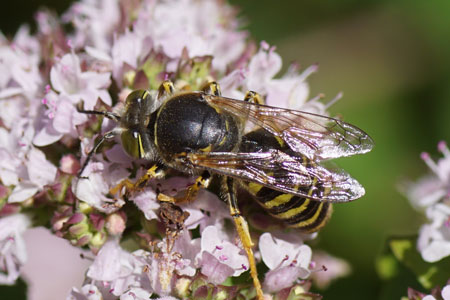 .. ..
 Bembix rostrata. Tribe Bembicini, subfamily Bembicinae. Family
Crabronidae.
Bembix rostrata. Tribe Bembicini, subfamily Bembicinae. Family
Crabronidae.
The largest wasp in the family Crabronidae in the Netherlands. In sandy regions such as the dune area. Nests in the sand with only one larva that gets prey (mainly hoverflies and other flies). A yellow-black abdomen with wavy bands and green eyes. A beak-shaped
'upper lip'. Length 15-22 mm. June-September. Photos 20-7-2020. |
 .. ..
 Cerceris rybyensis. Tribe
Cercerini, subfamily Philanthinae. Family Crabronidae.
Cerceris rybyensis. Tribe
Cercerini, subfamily Philanthinae. Family Crabronidae.
The prey are the bees Halictus, Lasioglossum and Andrena. It stocks its nests with these solitary bees.
They like to nest in groups. They make a corridor right downwards with side
corridors with a cubbyhole on end.
Length 8-12 mm.
June-September. Photos 21-8-2010. |
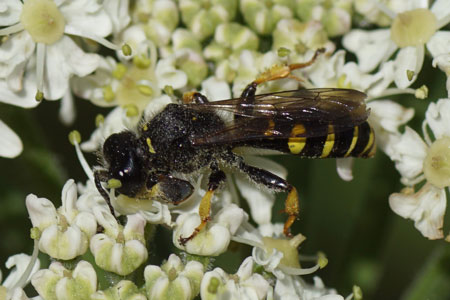 Crabro cribrarius.
Tribe Crabronini, subfamily Crabroninae. Family:
Crabronidae. Not in the garden, but 2 km from home.
Crabro cribrarius.
Tribe Crabronini, subfamily Crabroninae. Family:
Crabronidae. Not in the garden, but 2 km from home.
Especially warm, sandy biotopes. Flight period from May to September. Nests in sandy or loamy soil, sometimes in rotten wood. 15 to 20 cm long main corridor with one nest cell and later two or three side corridors with nest cell with flies as prey. Length male 9-16 mm, female 10-16 mm. Photo 17-7-2021.
|
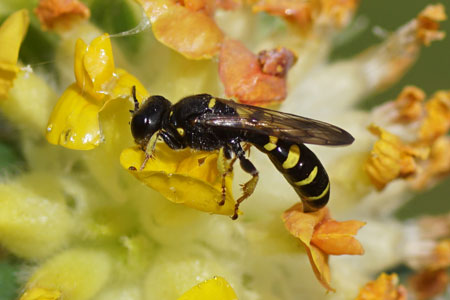 Crabro peltarius.
Tribe Crabronini, subfamily Crabroninae. Family:
Crabronidae.
Crabro peltarius.
Tribe Crabronini, subfamily Crabroninae. Family:
Crabronidae.
Mainly poor and dry sandy areas, but also nests in dry clay and loam. Flight period from May to October. Approximately 30 cm long, winding main corridor with up to seven nest cells with flies as prey. Length male 9-12 mm, female 9-13 mm Photo 29-5-2024.. |
 Crossocerus maybe Crossocerus nigritus.
Tribe Crabronini, subfamily Crabroninae. Family:
Crabronidae. Crossocerus maybe Crossocerus nigritus.
Tribe Crabronini, subfamily Crabroninae. Family:
Crabronidae.
Ivo
Raemakers (translated): I can't see the number cubitaalcels, but given the habit and
the not stemmed the abdomen, the thighs thickened and the structure of the
propodeum, I
think Crossocerus. Thanks Ivo. Maybe Crossocerus nigritus. Photo 30-4-2010. |
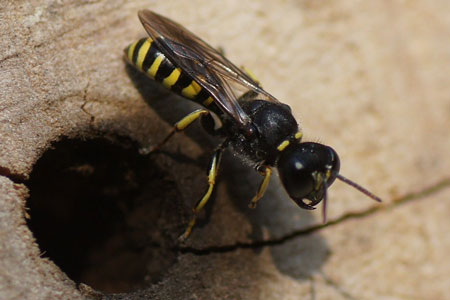 Ectemnius spec. Genus Ectemnius.
Tribe Crabronini, subfamily Crabroninae. Family: Crabronidae.
Ectemnius spec. Genus Ectemnius.
Tribe Crabronini, subfamily Crabroninae. Family: Crabronidae.
There are many similar species.
Females make their nest in decayed wood and they mainly supply it with hoverflies
(Syrphidae). They are solitary wasps, but they sometimes have the same
entrance to their nests.
Species of the Ectemnius family don't dig in sand.
Length 14 mm.
June-October. Photos: 14-6-2012. |
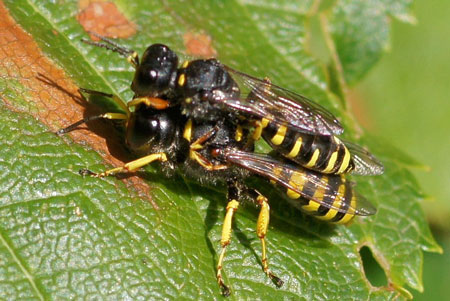 . .
 Ectemnius cavifrons. Genus Ectemnius.
Tribe Crabronini, subfamily Crabroninae. Family: Crabronidae.
Ectemnius cavifrons. Genus Ectemnius.
Tribe Crabronini, subfamily Crabroninae. Family: Crabronidae.
I also had this photo with a female and male as unknown, until Flor Rhebergen identified them as Ectemnius cavifrons. See her explanation on
Waarneming.
(in Dutch)
June-October.
Photos:
3-7-2011, |
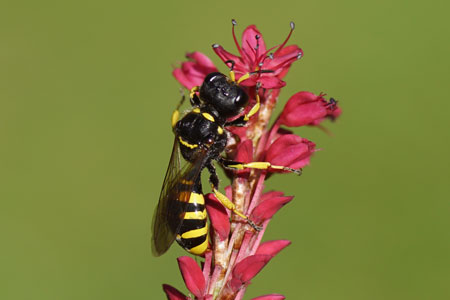 . .
 Ectemnius cephalotes. Genus Ectemnius.
Tribe Crabronini, subfamily Crabroninae. Family: Crabronidae.
Ectemnius cephalotes. Genus Ectemnius.
Tribe Crabronini, subfamily Crabroninae. Family: Crabronidae.
Dentified by Flor Rhebergen.. Photos 11-8-2021. |
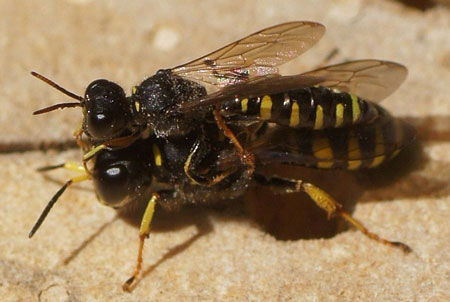 Ectemnius ruficornis. Genus Ectemnius.
Tribe Crabronini, subfamily Crabroninae.
Family: Crabronidae.
Ectemnius ruficornis. Genus Ectemnius.
Tribe Crabronini, subfamily Crabroninae.
Family: Crabronidae.
This female and male were also identified by Flor Rhebergen.
Photo 14-6-2012. |
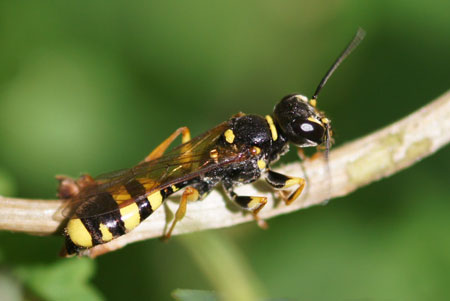 .. ..
 Field digger wasp
(Mellinus arvensis). Tribe Mellinini, subfamily Mellininae. Family:
Crabronidae. Field digger wasp
(Mellinus arvensis). Tribe Mellinini, subfamily Mellininae. Family:
Crabronidae.
Features: A narrow waist. The abdominal segments 2-5 have a yellow band. In section 4, the yellow band
is broken.
Flies of the family muscidae are often used as prey.
The nest is underground.
Length about 12 mm.
July-October.
Photos
24-9-2010.

 9-9-2014. Pictures of the nests of the field digger
wasps in our lawn.
9-9-2014. Pictures of the nests of the field digger
wasps in our lawn. |
 .. ..
 . .
 Nysson spec.
Tribe Nyssonini, subfamily Bembicinae. Family: Crabronidae. Nysson spec.
Tribe Nyssonini, subfamily Bembicinae. Family: Crabronidae.
The species are very similar. There are seven species in the Netherlands. The two most common species are the Nysson spinous and Nysson
trimaculatus.
It 's a black wasp with yellow spots on the abdomen and pronotum. Unlike a lot of
similar marked digger wasps, the legs are black.
Like the cuckoo bees they put their eggs in the nest of another digger wasp. The lava of the Nysson first feeds on the egg of the digger wasp and than it feeds on the prey, which was left in the nest.
Photos 26-7-2015. |
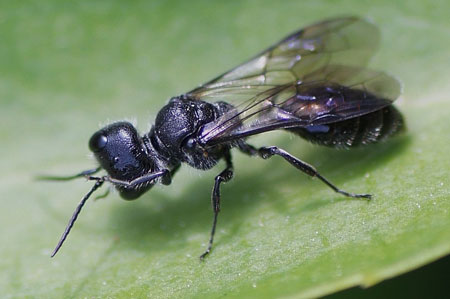 .. ..
 . .
 Aphid Wasp (Pemphredon spec). Tribe Pemphredonini,
subfamily Pemphredoninae. Family: Crabronidae.
Aphid Wasp (Pemphredon spec). Tribe Pemphredonini,
subfamily Pemphredoninae. Family: Crabronidae.
The species is not known. (12 species in Europe) A black wasp with a petiolate abdomen.
They make their nests in hollow stems, twigs, holes in wood. Each cell is supplied with aphids.
May-October.
Photos 13-6-2013. |
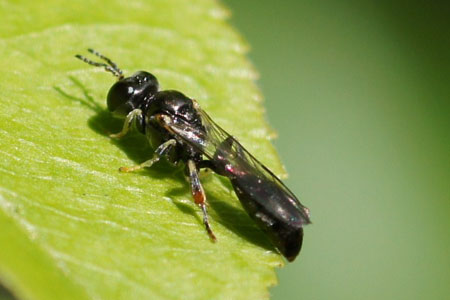 .. ..
 . .
 Rhopalum coarctatum.
Tribe Crabronini, subfamily Crabroninae. Family: Crabronidae. Rhopalum coarctatum.
Tribe Crabronini, subfamily Crabroninae. Family: Crabronidae.
A black wasp. The orange spot on the hind shins is striking.
The legs are pale yellow with black. The male has strange antennas. Just visible in the picture.
Length of male 4.5 to 6.5 mm. Female: 6 to 7.5 mm.
Nests in stems, rotten wood. Their preys are mosquitoes, dust lice. Europe, Asia (to Japan) and North America.
April-September. Photos 21-5-2011. |
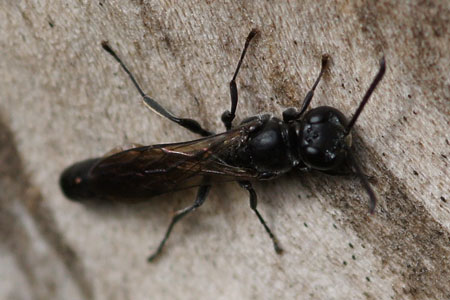 .. ..
 Trypoxylon figulus. Tribe
Trypoxylini, subfamily Crabroninae. Family: Crabronidae. Trypoxylon figulus. Tribe
Trypoxylini, subfamily Crabroninae. Family: Crabronidae.
An all-black, slender wasp. Like the spider wasps the Trypoxylon figulus
catch spiders (small), which are used as food for the larvae. They close their nest holes
(in plant stems, holes in wood, etc.) with some clay.
Length 8-15 mm. The male is much smaller than the female.
May-September.
Photos 19-6-2011. German:
Töpfergrabwespe. |
Sphecidae.
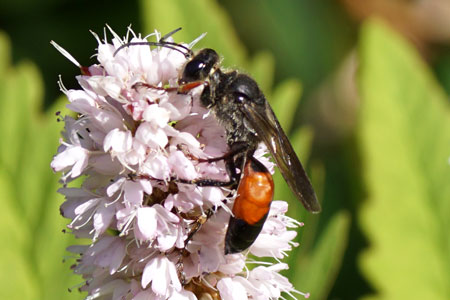 Golden Digger Wasp, Sphex funerarius. Family Sphecidae.
Golden Digger Wasp, Sphex funerarius. Family Sphecidae.
Length 15-23 mm. July, August. The females dig a nest in a sandy area. The prey for the nests are generally nymphs of grasshoppers or katydids. Black with an orange-red broad band on the anterior part of the abdomen. Head and body with fine and thin hair. Yellowish forewings with dark tips.
|
| Bees (Apidae), superfamily Apoidea, order
Hymenoptera.
When I think of bees, I always think of social honey bees and
beekeepers. But there are more solitary species. They all feed on (
also the larvae) nectar and polllen. Bumble bees are close relatives
of the honey bees. |
Solitary bees
Genus Antophora.
Familiy Apidae.
Bumblebee-like bees.
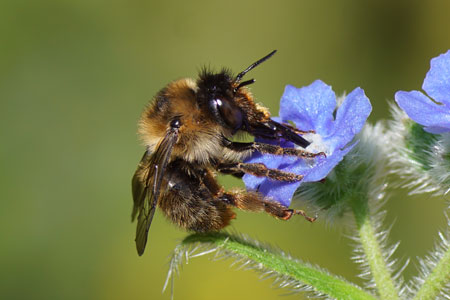 .. ..
 Fork-tailed Flower Bee (Anthophora furcata).
Genus Anthophora. Family Apidae. Rare in the Netherlands!!
Fork-tailed Flower Bee (Anthophora furcata).
Genus Anthophora. Family Apidae. Rare in the Netherlands!!
Brown/grey hairs on the thorax, black-grey color of the abdomen. With their long tongue especially on
flowers from the mint family (Lamiaceae) and borage family (Boraginaceae). Nests in rotten wood of old trees.
Length female 11-13 mm, length male 10-12 mm. May-September. Europe. Photos 16-6-2021. |
 .. ..
 Female.
Female.  Male.
Male.  On corydalis.
On corydalis.
Hairy-Footed Flower Bee (Anthophora plumipes). Subfamily
Apinae. Family Apidae.
In the garden they are hard to photograph. They are very mobile. I see this year for the first time some
Hairy-Footed Flower Bees in the garden. Both male and female were flown into the
scullery. When I let them out again, they stayed here on the sheet, so I could take a picture.
Now it is easy to compare the male and female. I see them (late March), especially
on lungworts (Pulmonaria) . Other visited flowers are for example,
deadnettle, corydalis.
They look like small bumblebees. The coat is long, dense and brown. The male has elongated middle legs with long hairs on the tarsus segments. (see photo).
They are solitary bees. They have nests in clay slopes and steep walls of mud.
Europe, Near East, North Africa and introduced in the 20th century into the U.S.
Length: 14-16 mm.
March-June. German: Gemeine Pelzbiene. Photos 24-03-2012, 21-03-2012, 15-4-2013.
|
Mining
Bees (Andrenidae).
Solitary bees. Some mining bees make nests in the ground vertically, other
species horizontally. There are also differences in size and flight of the
species. There are 72 species in the Netherlands.
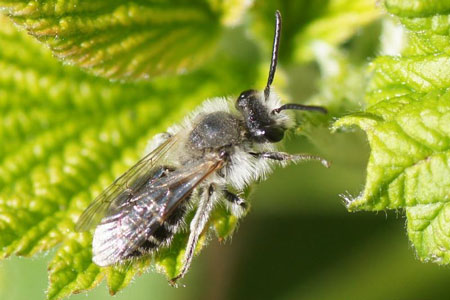 Bearded miner bee (Andrena barbilabris). Male.
Family Mining
Bees (Andrenidae).
Bearded miner bee (Andrena barbilabris). Male.
Family Mining
Bees (Andrenidae).
Females with reddish-brown hairs on the top of the thorax and yellower hairs on the sides and head. The males with silvery, long light hairs on the thorax.
Length 10-12mm. March-July. Europe, North Asia (excluding China) and North America. Photo 13-4-2012. |
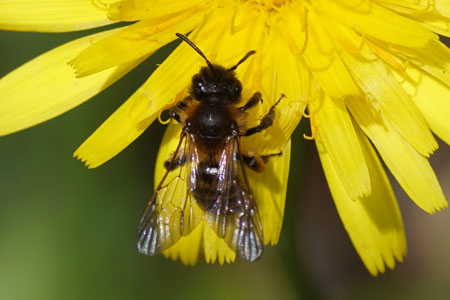 .. ..
 Gwynne's mining bee (Andrena bicolor). Family Mining
Bees (Andrenidae).
Gwynne's mining bee (Andrena bicolor). Family Mining
Bees (Andrenidae).
A bee with two-tone hair. The thorax is reddish brown and the abdomen black. On different soil types.
Female length 9-10 mm, male length 8-10
mm. Februari-September. Europe, Central Asia. Photos 8-7-2020. |
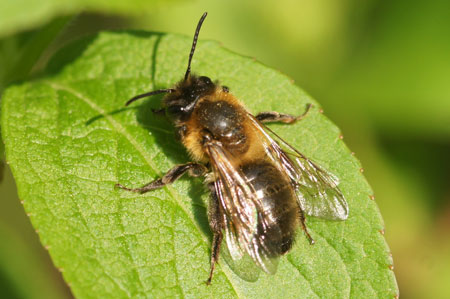 .. ..
 Chocolate mining bee, hawthorn bee (Andrena
carantonica). Family Mining
Bees (Andrenidae). Female
Chocolate mining bee, hawthorn bee (Andrena
carantonica). Family Mining
Bees (Andrenidae). Female
A bee with ocher yellow hairs. Head is partly black and
with yellow-brown hairs. Female abdomen is completely or to a large extent black, in the males are many segments of the abdomen yellow-brown hairy.
No preference for a biotope.
Many females use the same entrance for their nest in the sandy soil. Then they dig their own cell for their brood.
Food from many types of plants. They often visit the flowers of flowering maple trees.
Female length 13-14 mm, male length 10-13 mm.
March-mid July. Europe.
Photos 22-4-2018. |
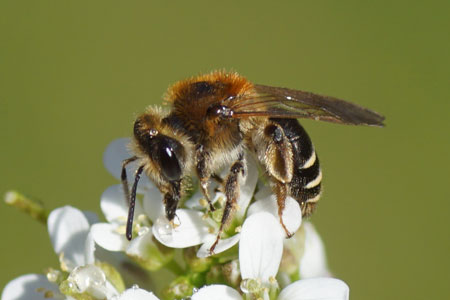 Short-fringed Mining Bee
(Andrena dorsata). Family Mining
Bees (Andrenidae). Female
Short-fringed Mining Bee
(Andrena dorsata). Family Mining
Bees (Andrenidae). Female
Head and thorax yellow-brown hairy. Abdomen black with light hair bands.
All kinds of open landscapes. Common in the southern part of the Netherlands. First seen in our garden in North Holland in 2025.
Food of many types of plants.
Length female 9-10 mm, length male 7-8 mm. Flight period: March-September. Two generations. Europe. Photo 2-4-2025. |
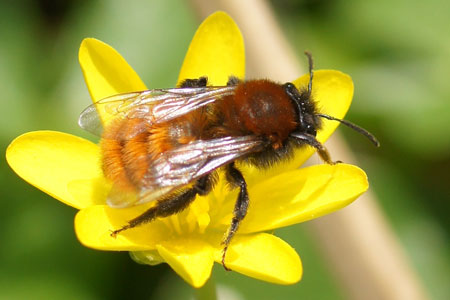 .. ..
 . .
 Tawny Mining Bee (Andrena
fulva). Family Mining
Bees (Andrenidae). Female Tawny Mining Bee (Andrena
fulva). Family Mining
Bees (Andrenidae). Female
It looks a bit like a bumblebee with his long
foxy red brown hairs. The legs are black.
You can often find them (also in our garden) on currants, gooseberries and other Ribes species.
Solitary. The females make the nest in sandy soil. Sometimes in the garden.
Small sand heaps with entrance hole in the middle. Diameter: 9 mm. Depth:
20 - 40 mm. The branched hole has oval cells. In each cell are pollen,
nectar and one egg.
Sometimes there are many nests together. But every bee has its own nest.
Length female 12-14 mm, length male 9-11
mm.
March-May. Photos March, April 2012. German: Rotpelzige Sandbiene. |
 .. ..
 Early Mining Bee,
Orange-tailed Mining Bee
(Andrena haemorrhoa). Family Mining Bees
(Andrenidae). Female. Early Mining Bee,
Orange-tailed Mining Bee
(Andrena haemorrhoa). Family Mining Bees
(Andrenidae). Female.
The thorax has on the upperside red hairs and white hairs on the underside. The front of the head is white hairy. The abdomen is shiny black with red hairs at the end. (which is hard to see in this picture.)
They make the nest on sandy places. Sometimes alone, sometimes in a group.
March-July. Palearctic.
Length females 10-11 mm, length males 9-11 mm.
Photos 5-5-2013. German: Rotschopfige Erdbiene
 Male 9-4-2014.
Male 9-4-2014. |
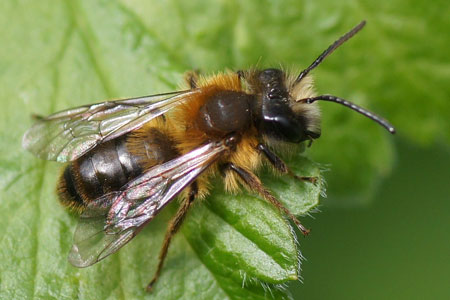 Andrena helvola group. Family Mining
Bees (Andrenidae). Andrena helvola group. Family Mining
Bees (Andrenidae).
In the Netherlands this group is named after the Andrena helvola.
Other species in this group are Andrena fucata, Andrena mitis, Andrena praecox
and Andrena varians. Espacially the males are very difficult to identify from a photo.
Photo 5-4-2014. |
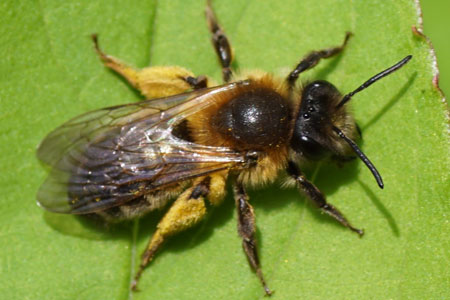 .. ..
 Buffish Mining Bee
(Andrena nigroaenea). Female. Family Mining
Bees (Andrenidae).
Buffish Mining Bee
(Andrena nigroaenea). Female. Family Mining
Bees (Andrenidae).
A dark brown abdomen without clear hair bands. Yellow-brown hairs on the hind legs and side of the thorax. The thorax is brownish hairy.
It occurs in all kinds of areas. In early spring mainly on willow flowers, then on many other flowers. Nests alone or in small colonies.
March-mid June. Length females 12-15 mm, length males 11-14 mm. Photos 12-4-2024.
Determined by Kees Goudsmits. |
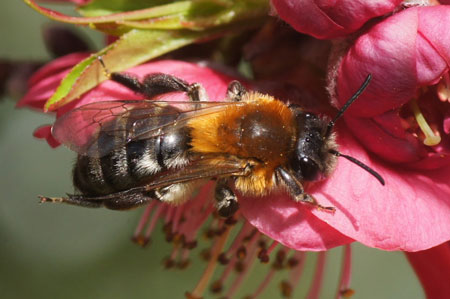 .. ..
 Andrena nitida. Family Mining
Bees (Andrenidae). Andrena nitida. Family Mining
Bees (Andrenidae).
The thorax has on the upperside orange brown
hairs. The side at the bottom is white hairy. The abdomen is shiny black. Females have thin apical side-bars of white pubescence on abdominal
segment 2 and 3. The male is harder to identify.
It lives in all kinds of fields. On many flowers, but with preference for buttercups, dandelions and willow. The bee on the photo, however, had a preference for the flowers of the peach.
March-mid-July.
Length females 12-15 mm, length males 12-13 mm. Photos 16-4-2018. |
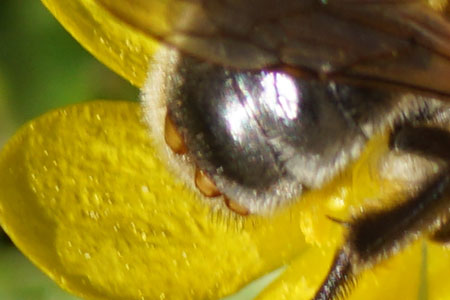 .. ..
 Females Stylops melittae (similar to Stylops ater) on the abdomen of a Andrena nitida. Family Stylopidae. Order
Strepsiptera.
Females Stylops melittae (similar to Stylops ater) on the abdomen of a Andrena nitida. Family Stylopidae. Order
Strepsiptera.
They are endoparasites that parasitize mining bees species. The wingless female has a hardened head-thorax (cephalothorax). That part protrudes beyond the sand bee's tergites. The male only has hind wings and is short lived. The pupa of the males
(pupa shape) also sticks out between the tergites of the sand bee. They mate on the dazed
mining bee. Photos 3/29/2021.
Much more information and photos on Albert
de Wilde's website. He wrote an article
about it. Unfortunately only in Dutch. |
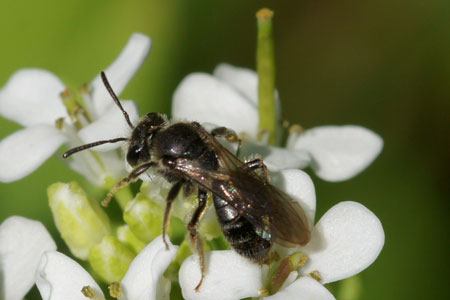 .. ..
 . .
 . .
 . .
 Andrena subopaca. Family Mining
Bees (Andrenidae).
Andrena subopaca. Family Mining
Bees (Andrenidae).
I'm not quite sure. It is the most common wasp in the Netherlands
of the Andrena minutula group. These are small black bees, which are difficult to
identify. Other species, which belong to this group, are Andrena minutula, Andrena
minutuloides, Andrena Saunders ella, Andrena falsifica and Andrena
viridescens.
In these pictures it is on Alliaria officinalis or Alliaria petiolata. At the top picture with a beetle
(Byturus)
Sparsely hairy. Both on the head, thorax and the body are white hairs. The tip of the abdomen is brown. That is hard to see.
(picture on the bottom)
Length 5-7 mm.Flight: March-August
Photos
4-6-2010. |
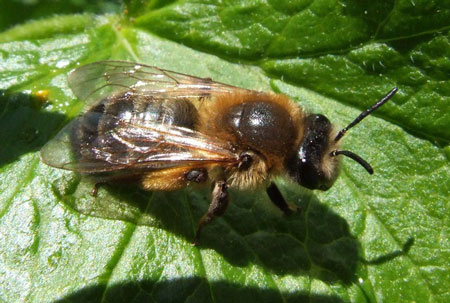 .. ..
 . .
 . .
 Andrena
tibialis. Family Mining
Bees (Andrenidae). female. Andrena
tibialis. Family Mining
Bees (Andrenidae). female.
At first I thought it was an Andrena carantonica. But Ivo
Raemakers commented: Because a whole orange scopa: no A. carantonica. Because
light hairy face: no A. nigroaenea. Remains A. tibialis. Thanks Ivo.
The number Andrena carantonica in the Netherlands seems to have decreased.
Length 8, 9 mm.
Flight: March-June. Photo 17-4-2010. |
Plasterer bees, polyester bees Colletidae.
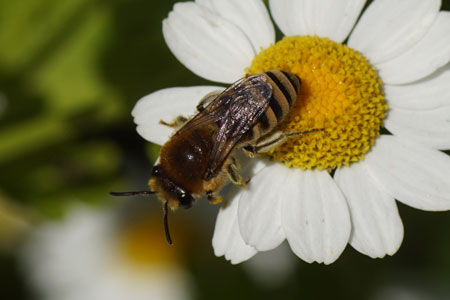 .. ..  Colletes daviesanus, Colletes fodiens or Colletes similis. Subfamiliy Colletinae.
Familiy Colletidae
Colletes daviesanus, Colletes fodiens or Colletes similis. Subfamiliy Colletinae.
Familiy Colletidae
Three very similar species, often found on plants from the genus Tanacetum, family Asteraceae (Composite family), (Here on feverfew). Only Colletes similis is quite rare in the Netherlands. Photos 28-6-2022. |
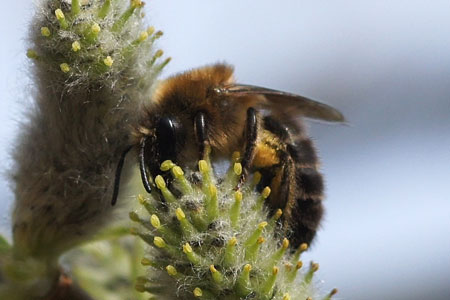 .. .. Vernal colletes or spring mining bee (Colletes cunicularius). Subfamiliy Colletinae.
Familiy Colletidae. Not in the garden, but in the dunes about 4 km from my house.
Vernal colletes or spring mining bee (Colletes cunicularius). Subfamiliy Colletinae.
Familiy Colletidae. Not in the garden, but in the dunes about 4 km from my house.
An early, large bee, which, as in the photo, can often be found on willows. Nests in sandy soil. Hibernates as an image. A black abdomen with no obvious transverse bands and a thorax with brown hair. Length female 13-15 mm, male 11-14 mm. March-June. photos
30-4-2014. |
 Hylaeus communis. Subfamily:
Hylaeinae. Family Colletidae. female.
Hylaeus communis. Subfamily:
Hylaeinae. Family Colletidae. female.
In the picture the bee blows a bubble. Bees are blowing nectar bubbles (bubbling) to make water evaporate and thus to increase the nectar concentration (nutritional value)
and for self-cooling. In this way they thicken the nectar they have gathered.
Thanks for this information: Pietsje and Theo. Photo 8-8-2012. |
Halictidae.
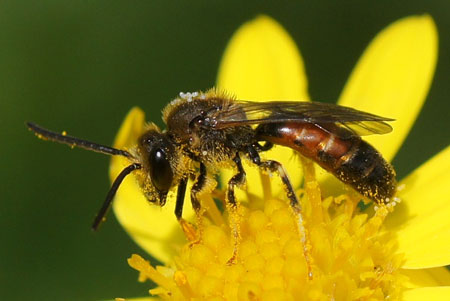 .. ..
 . .
 Lasioglossum calceatum or Lasioglossum
albipes. Family Halictidae. male
Lasioglossum calceatum or Lasioglossum
albipes. Family Halictidae. male
These two species are very similar. The females
have a sweet fragrance. It's a social bee. The female hibernates. In
spring it makes a nest in the ground. First the workers appear and then
the males and females. April-October. Photos 15-7-2012, 17-7-2012.
Lasioglossum calceatum Length females 8-9 mm, length males 8-10 mm.
Lasioglossum albipes Length females 8-9 mm, length males 8-10 mm. |
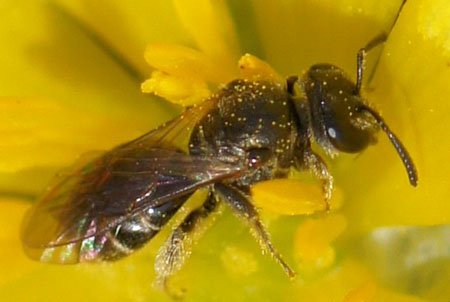 .. ..
 Lasioglossum sexstrigatum or
Lasioglossum sabulosum. Family Halicidae. female
Lasioglossum sexstrigatum or
Lasioglossum sabulosum. Family Halicidae. female
I often see these bees on the flowers of celandine in March.
According to Theo MJ Peeters (translated): They have white hair bands on the abdomen and then there are only two species: Lasioglossum sexstrigatum or Lasioglossum
sabulosum. Differ in detail features such as the
serration of the track on the hind legs ... Thank you Theo.
Lasioglossum sabulosum is rarer in the Netherlands. So I think probably a Lasioglossum
sexstrigatum.
They make their nests in sandy soil. The fertilized females overwinter. The males therefore appear in June.
Length 5-7 mm. March-October. Photos 24-03-2012. |
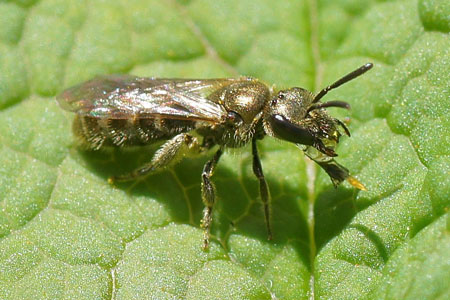 .. ..
 . .
 Lasioglossum spec. Subgenus Dialictus. Family Halicidae.
Lasioglossum spec. Subgenus Dialictus. Family Halicidae.
There are some very similar species: Lasioglossum leucopus, Lasioglossum morio and Lasioglossum
nitidulum.
They have a metallic shine.
Photos 5-05-2015. |
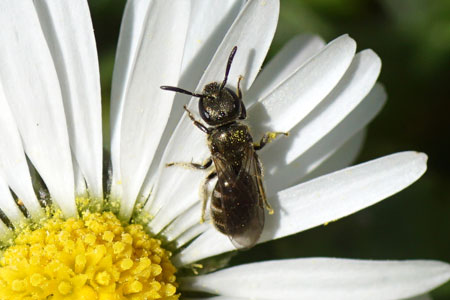 Lasioglossum morio. Female. Subgenus Dialictus. Family
Halicidae.
Lasioglossum morio. Female. Subgenus Dialictus. Family
Halicidae.
8 years after the photos above a bee, which was determined as a certain
Lasioglossum morio by Kees Goudsmits. Photo 2-04-2023. |
Leafcutter bees, Megachilinae.
A solitary bee. The species are often difficult to identify
from a photo.
Leafcutter bees cut circular pieces of leaves to
construct their nest. The nests are created in small holes in the
ground, but also in for example hollow plant stems. The nests contain several cells.
In each cell the bee with pollen and nectar the bee lays one egg. Leafcutter
bees have hairs on the
underside of the abdomen. (a kind of hairy brush) On these hairs they carry
pollen.
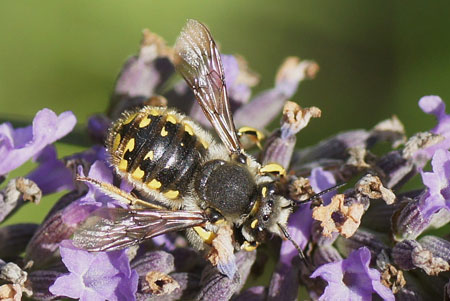 .. ..
 . .
 . .
 European wool carder bee (Anthidium
manicatum). Subfamily leafcutter bees (Megachilinae).
Family Megachilidae.
European wool carder bee (Anthidium
manicatum). Subfamily leafcutter bees (Megachilinae).
Family Megachilidae.
The European wool carder bee is yellow black like a wasp, but is more compact as a bumblebee. The hairs on the underside of the body (to carry the
pollen) are white.
This is a male. Which is larger than the female and has three black spines on the abdomen point. (showing on the middle left picture).
Males defend their territory against other males. They can also be aggressive to other bees and hoverflies.
The female makes the nest in cavities in masonry, clay, wood. The nest is lined with
scraped hairs from the leaves of plants like Dusty Miller and Lambs' ears.
May-September.
Photos 16. 17, 19 August 2012. German:
Große Wollbiene, French: L'abeille cotonnière .
  Female
on Lambs'ear. Photo 13-7-2013. Female
on Lambs'ear. Photo 13-7-2013. |
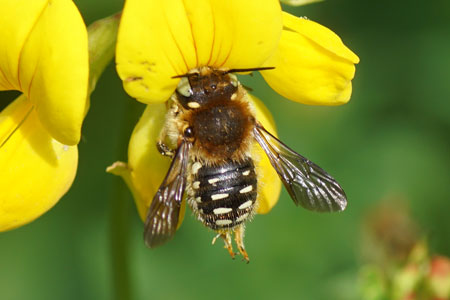 White-dotted wool-carder bee (Anthidium punctatum). Subfamily leafcutter bees (Megachilinae).
Family Megachilidae.
White-dotted wool-carder bee (Anthidium punctatum). Subfamily leafcutter bees (Megachilinae).
Family Megachilidae.
The Anthidium punctatum has a double row of white dots and transverse spots on the abdomen.
The female makes the nest in cavities. The nest is lined with plant hairs.
The Anthidium punctatum can mainly be found on various types of flowers, but has a preference for bird's-foot trefoil and
viper's bugloss In the photo on bird's-foot trefoil.
Females and males 8-9 mm. June-August. Photo 13-6-2020.
|
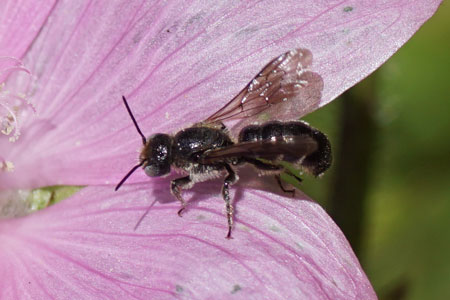 Chelostoma rapunculi. Subfamily leafcutter bees (Megachilinae).
Family Megachilidae.
Chelostoma rapunculi. Subfamily leafcutter bees (Megachilinae).
Family Megachilidae.
A black, slender bee with white hair bands on the abdomen. On
bellflower family (campanulaceae). Nest passages through beetle larvae or reed stems. Length 8-10mm. June July. Photo 7-7-2021. |
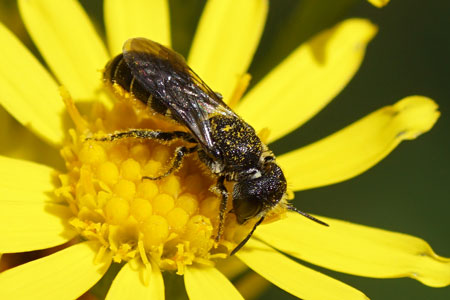 .. ..
 Heriades truncorum. Subfamily leafcutter bees (Megachilinae).
Family Megachilidae.
Heriades truncorum. Subfamily leafcutter bees (Megachilinae).
Family Megachilidae.
A small black bee with white hair bands on the abdomen. Face with
grey-white hairs. Female with a yellow hairs on the underside of the
abdomen. Nests mainly in old beetle corridors in wood, thatched roof stems. Length female 7-8 mm, male 5-7 mm. June-September.
Photo 20-7-2020, 21-7-2020. |
 .. ..
 Megachile Leaf-cutter bee (Megachile centuncularis). Subfamily leafcutter bees (Megachilinae).
Family Megachilidae.
Megachile Leaf-cutter bee (Megachile centuncularis). Subfamily leafcutter bees (Megachilinae).
Family Megachilidae.
The hairs
are yellowish brown. The hairs on the underside of the abdomen (to carry the
pollen) of the females are red and these hairs of the males are white.
They look like the Megachile versicolor. But the last part of the hairs on the
underside of the body of these bees is black.
They nest in holes in different places such as trees, walls, dead plant stems and bee hotels.
Often in the gardens in towns and cities. Length female 11-12 mm, male 9-11 mm.
July-August.
 More
photos of a leafcutting leafcutterbee!!!!!
More
photos of a leafcutting leafcutterbee!!!!!
|
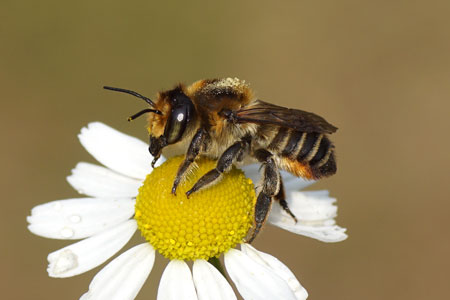 Coast leaf-cutter (Megachile maritima). Subfamily leafcutter bees (Megachilinae).
Family Megachilidae. Female.
Coast leaf-cutter (Megachile maritima). Subfamily leafcutter bees (Megachilinae).
Family Megachilidae. Female.
Yellow-faced males have yellow-brown hair with a dark brown backside. Female specimens are tan haired with black backside with light bands. The
underside of the body with white front white, red middle part and black backside. In the Netherlands mainly along the coast. Rare in other parts of the country.
They nest in the ground under stones, etc. covered with pieces of leaves.
Length 13-15 mm. May-September. Photo 9-7-2023. |
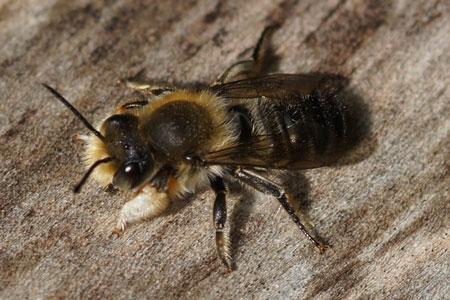 .. ..
 Willoughby's Leafcutter Bee (Megachile
willughbiella). Subfamily leafcutter bees (Megachilinae). male Family
Megachilidae.
Willoughby's Leafcutter Bee (Megachile
willughbiella). Subfamily leafcutter bees (Megachilinae). male Family
Megachilidae.
The head and thorax have yellowish brown hairs. Small bands of white hairs on the edge of the segments of the abdomen.
The male has expanded front tarsi, covered with long white hairs. The females
have conspicuous red fringes of hair (at the end black hairs), for carrying pollen, on the underside of their bodies.
They are nesting in holes in decayed wood, but also in large (6-9 mm) hollow reeds or in the ground. The
hole is lined with round / oval pieces of leaves, which they have cut.
Length 12-16 mm.
June-September.
Photos 4-6-2011.
 Female
2-7-2012 Female
2-7-2012 |
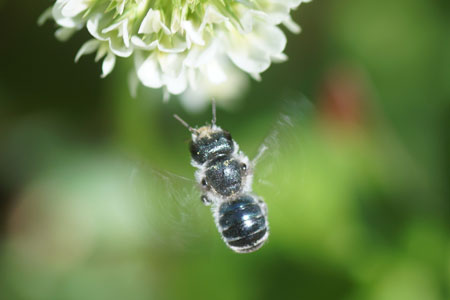 Blue mason bee (Osmia caerulescens). Genus
Osima. Subfamily leafcutter bees (Megachilinae).
Family Megachilidae.
Blue mason bee (Osmia caerulescens). Genus
Osima. Subfamily leafcutter bees (Megachilinae).
Family Megachilidae.
The female is metallic dark blue. The
underside of the abdomen has a kind black hairy brush. The males are more greenish. Especially on Fabaceae and Lamiaceae.
Female length 8-10 mm, male 7-9 mm. May-August. Photo 18-6-2019. |
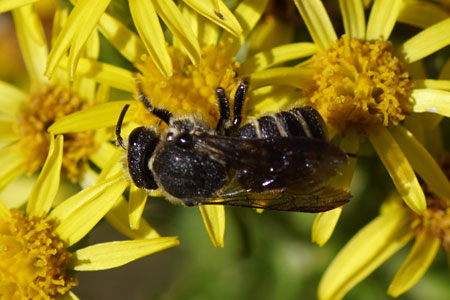 .. ..
 Stelis punctulatissima. Subfamily leafcutter bees (Megachilinae).
Family Megachilidae.
Stelis punctulatissima. Subfamily leafcutter bees (Megachilinae).
Family Megachilidae.
A black bee. Edges of the segments are light. Virtually hairless and strikingly punctured. A cuckoo bee, which lays the eggs in nests of all kinds of bees. Especially with the
European wool carder bee (Anthidium manicatum). Length 8-11 mm. May-August. Photos
13-7-2020. |
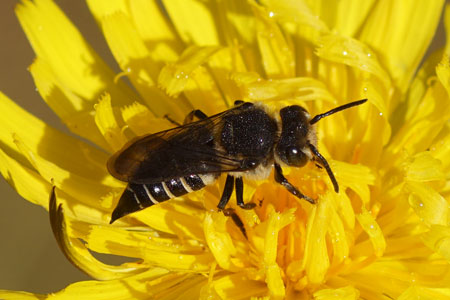 Leaf-cutting cuckoo bee, sharp-tailed bee (Coelioxyss).
Leaf-cutting cuckoo bee, sharp-tailed bee (Coelioxyss).
Sharp-tailed bees are parasitic. Females have pointed abdomens. These cuckoo bees are usually active from June to September, depending on the
host species. Similar to Nomadinae described at the bottom of the page,
they lay their eggs in the nests of bees. Especially of the genus
Megachile. They don't collect pollen and feed on nectar.
The species is uncertain. All species are rare in the Netherlands. See
Waarneming.
|
Melittidae.
A small bee family with the subfamilies Meganomiinae, Melittinae and Dasypodainae.
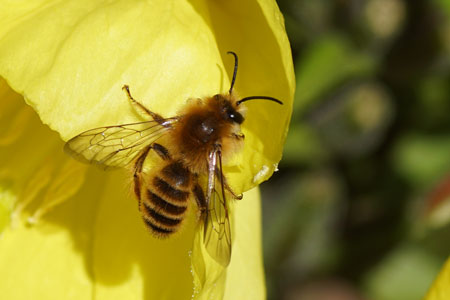 .. ..
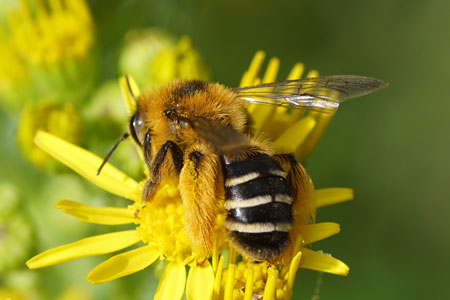 . .
 Dasypoda hirtipes. Subfamily Dasypodainae.
Family Megachilidae. Male and Female.
Dasypoda hirtipes. Subfamily Dasypodainae.
Family Megachilidae. Male and Female.
Females with bright yellow coloured hair on the hind legs and with bright white cross
stripes. Partially black back, head and broad rear tip. Males can be ocher brown, but also
grey. With cross stripes and a pale face.
Nest in sand and between stones. Main corridor can be 30 to 110 cm deep, with side corridors with brood
cells.
Length 12-15 mm. June August. Photo 13-7-2020.
|
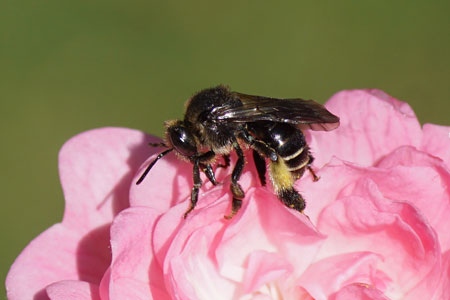 Macropis europaea. Female. Subfamily Macropidinae.
Family Megachilidae.
Macropis europaea. Female. Subfamily Macropidinae.
Family Megachilidae.
Stocky and largely glossy black due to the few hairs. White hair bands on the last tergites and white hair on the shins. Male with yellow face.
Mainly found on yellow loosestrife Lysimachia vulgaris, but other flowers are also visited for pollen. Coincidentally here on a rose.
Nest in the ground.
Length 8-9 mm..June-August. Photo 7-7-2022.
|
Parasitic bees
Nomadinae.
A cuckoo bee. In the Netherlands, there are 43
species. Many species are very similar. It looks like a wasp.
Like a cuckoo, they lay their eggs in nests of
other bee species. Often of mining bees. The nomada larvae kill the larvae
of the host, when they grow up.
Like other bees the nomada feeds on nectar and
pollen. But it lacks a pollen-carrying scopa. (Modifications
on the body of a non-parasitic bee for carrying pollen.) Parasitic bees
don't need to transport pollen. April - August.
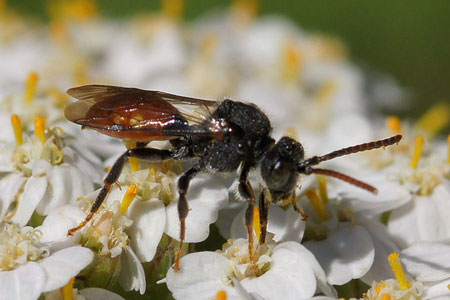 .. ..
 Nomada fabriciana. Subfamily Nomadinae. Family
Apidae.
Nomada fabriciana. Subfamily Nomadinae. Family
Apidae.
March-August. 7-10 mm. Photo 14-6-2011.
|
 .. ..
 Nomada goodeniana. Subfamily Nomadinae. Family
Apidae.
Nomada goodeniana. Subfamily Nomadinae. Family
Apidae.
March-June. 10-14 mm.
Photo 16-5-2010. |
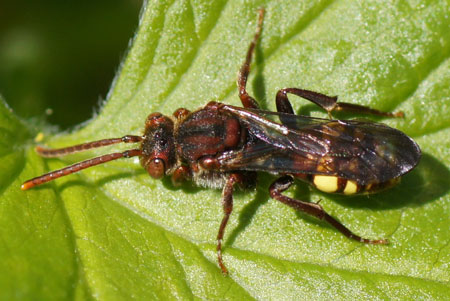 .. ..
 Nomada panzeri. Subfamily Nomadinae. Family
Apidae.
Nomada panzeri. Subfamily Nomadinae. Family
Apidae.
March-June.
Photos 12-4-2012. |
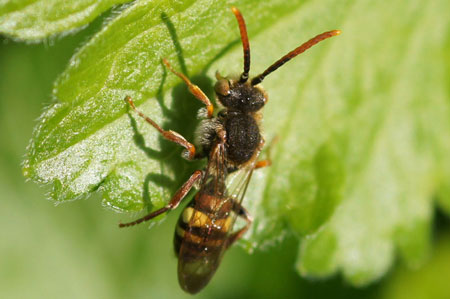 .. ..
 Nomada ruficornis. Subfamily
Nomadinae. Family Apidae.
Nomada ruficornis. Subfamily
Nomadinae. Family Apidae.
March-July. 8-11 mm.
Photo 17-4-2011.
|
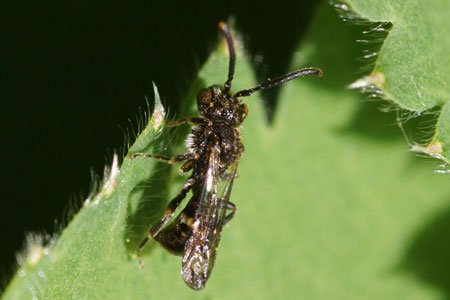 Nomada sheppardana. Subfamily Nomadinae.
Family Apidae.
Nomada sheppardana. Subfamily Nomadinae.
Family Apidae.
April-August. 4-7 mm.
Photo 14-5-2010. |
Epeolus.
Bees of the genus Epeolus are cuckoo bees. Ze parasiteren op Zijdebijen
(Colletes). They are parasites of plasterer bees (Colletes). Besides the two
species below, there are in the Netherlands the rare Epeolus tarsalis and
Epeolus alpinus.
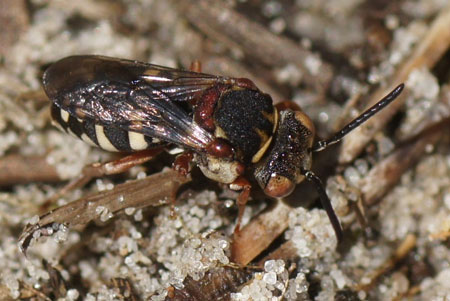 Epeolus cruciger or Epeolus cruciger.
Subfamily Anthophorinae. Family Apidae. Not in our garden but in the dunes
about 4 km from our home.
Epeolus cruciger or Epeolus cruciger.
Subfamily Anthophorinae. Family Apidae. Not in our garden but in the dunes
about 4 km from our home.
A black bee with white spots and a red-brown and reddish-brown scutellum shoulders.
The differences between the two species are small. The females Epeolus variegatus have black
hind thighs (but that may be on the underside!) And Epeolus cruciger has red hind thighs.
Photo 19-08-2013. |
Halictidae.
Like wasp bees Sphecodes are parasitic bees. (Most of groove bees) Many species are also very difficult to identify from a photograph. Usually they are black with a partially red abdomen. In the Netherlands there are 20 species. They don't carry pollen. Especially in the sandy areas they are common. (dunes)
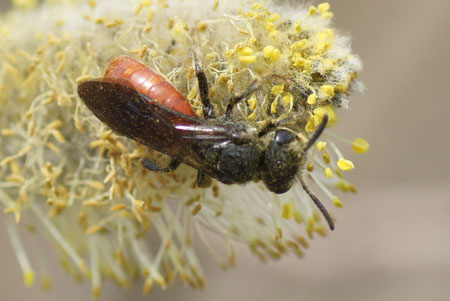 .. ..
 . .
 Sphecodes albilabris. Family Halictidae.
Not in our garden but in the dunes
about 4 km from our home.
Sphecodes albilabris. Family Halictidae.
Not in our garden but in the dunes
about 4 km from our home.
In Europe, this is the largest Sphecodes species. Head and thorax are black, the abdomen is red, only the last segment is dark.
White hairs on the front of the head (In particular the males). The wings are dark
tinted (The females darker). The larvae of
Sphecodes albilabris are parasites to the Colletes cunicularius.
It occurs mainly on sandy soils, like the dunes. (on a flower of a willow tree)
Length 11-14 mm.
March-September Central and Western Europe. Photos 21-4-2013.
 Sphecodes albilabris. Family Halictidae
Now also in our garden 5-9-2023. Sphecodes albilabris. Family Halictidae
Now also in our garden 5-9-2023. |
 Sphecodes monilicornis. Family Halictidae.
Sphecodes monilicornis. Family Halictidae.
This bee is easy to recognize. The head of Sphecodes monilicornis is behind the eyes wide, as in this photo shows.
The first three segments of the abdomen of the female are red. Of the fourth segment
only the side is the red.
Lasioglossums are the host.
You can find them mostly in a sandy, dry area.
Length 7-10 mm.
March-October.
Photo female 4-7-2011.
|
I want to thank everyone, who has helped me on waarneming.nl and forum.hymis.de
to identify.
Nederlands /
Dutch
 
Subpage flies:
Tachinidae
Blow-flies
(Calliphoridae) House
flies (Muscidae) Soldierflies
(Stratiomyidae) Root-Maggot
Flies (Anthomyiidae)
Small
flies Gnats
Subpage wasps, bees, bumblebees: Parasitica, Ichneumonidae
Sawflies
symphyta Bumblebees
Bee hotel
Leaf-cutter bee
Subpage France: Insects
France
|
